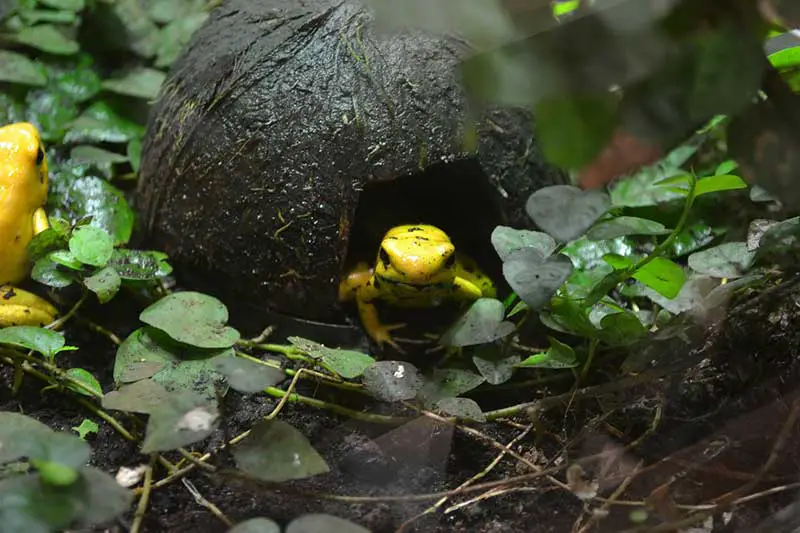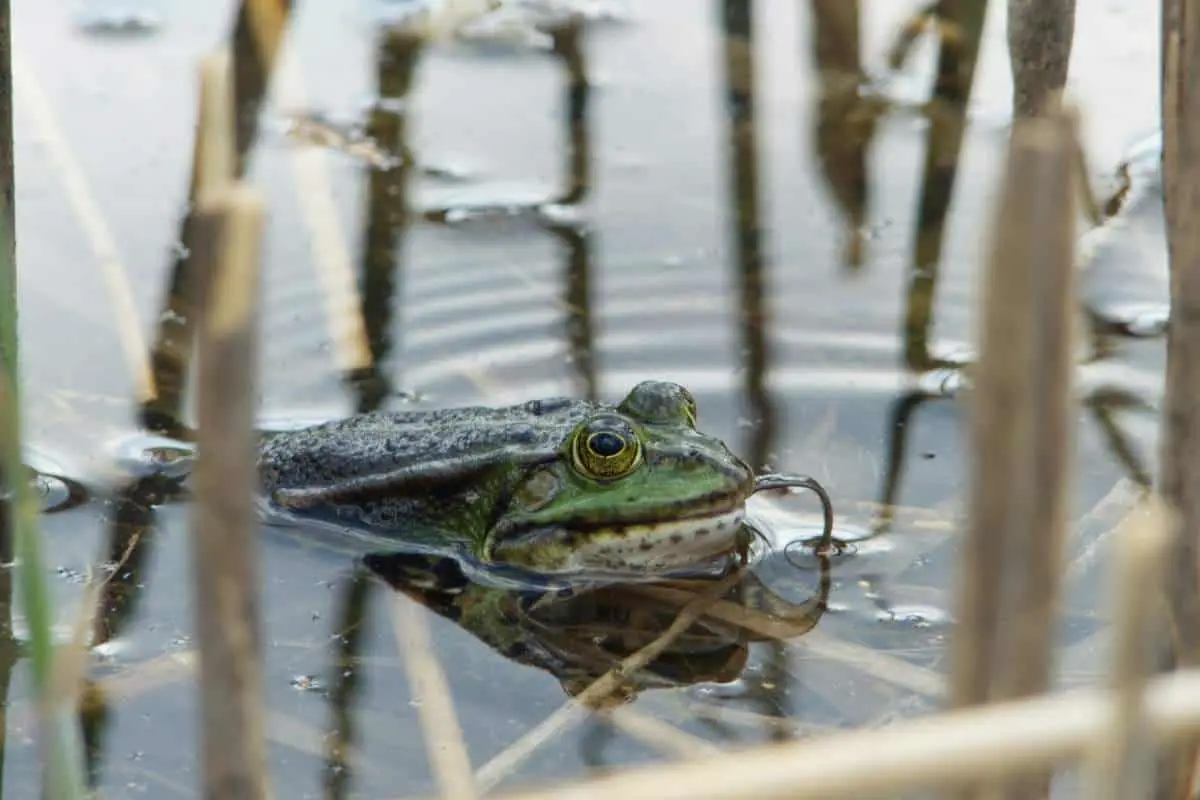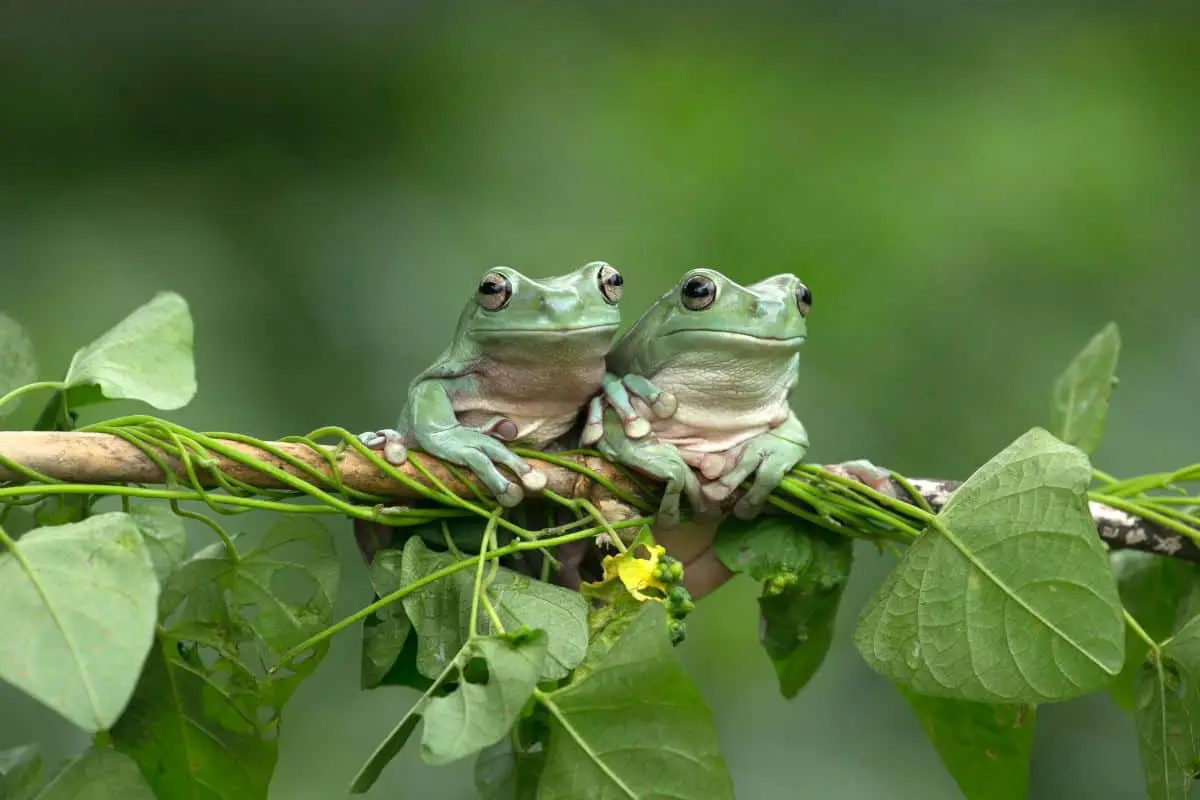In North America when we think of poisonous frogs we tend to think of the invasive cane toad. In other parts of the world though, there are frogs that are far more poisonous, many are deadly. These poisonous frogs are instantly recognizable because of their bright, beautiful colors and small sizes. They’re famous as a source of poison for hunting darts, but also for their beauty. They’re also highly popular in the exotic pet trade and in zoos.
Most species obtain their poison from their diet, which means that captive frogs actually aren’t poisonous. Many of these frogs, in the wild, produce a poison so toxic that one frog could kill multiple people.
World’s 16 Most Poisonous Frogs
For our list of the most poisonous frogs in the world, we have the following species: the golden poison dart frog, black-legged poison dart frog, blue poison dart frog, phantasmal poison dart frog, dyeing dart frog, strawberry poison dart frog, kokoe poison dart frog, lovely poison dart frog, Golfodulcean poison frog, red-backed poison frog, variable poison frog, green and black poison dart frog, granular poison frog, yellow-banded poison frog, Harlequin poison frog, and the Corroboree frog.
1. Golden Poison Dart Frog
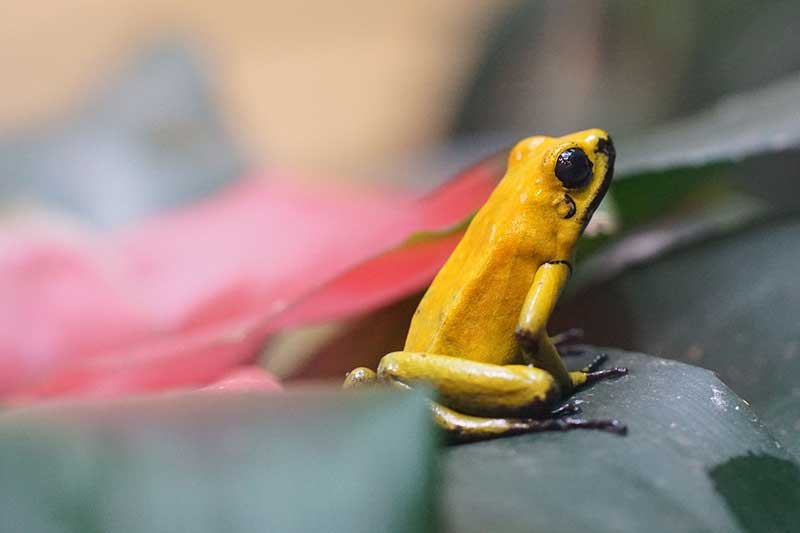
Scientific Name: Phyllobates terribilis
The most poisonous frog in the world, and possibly the most poisonous animal in the world of any kind, the Golden Poison Dart Frog produces enough poison to deliver a fatal dose to 10 humans. Like many tropical species, it is endangered due to habitat loss.
Also like most poison frogs, the Golden poison dart frog doesn’t produce its own poison. Instead, it derives its poison from the insects it eats, which means that the toxicity of any given frogs poison is directly tied to how well it’s been eating.
2. Black-legged Poison Dart Frog
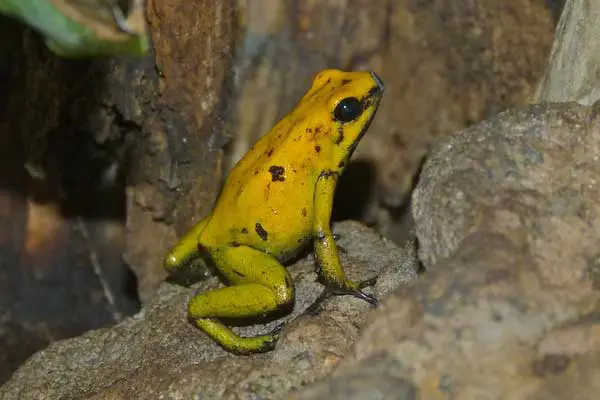
Scientific Name: Phyllobates bicolor
The black-legged poison dart frog is very similar in appearance to the golden poison dart frog and is also one of the most poisonous frogs in the world, because the two species are closely related. Both have historically been used to poison darts that were used to kill humans. Black-legged poison dart frogs live in Colombia, where they are endangered as a result of habitat loss.
They are smaller than Golden Poison Dart frogs, and their poison is slightly weaker, but only slightly. These are still remarkably dangerous little frogs.
3. Blue Poison Dart Frog
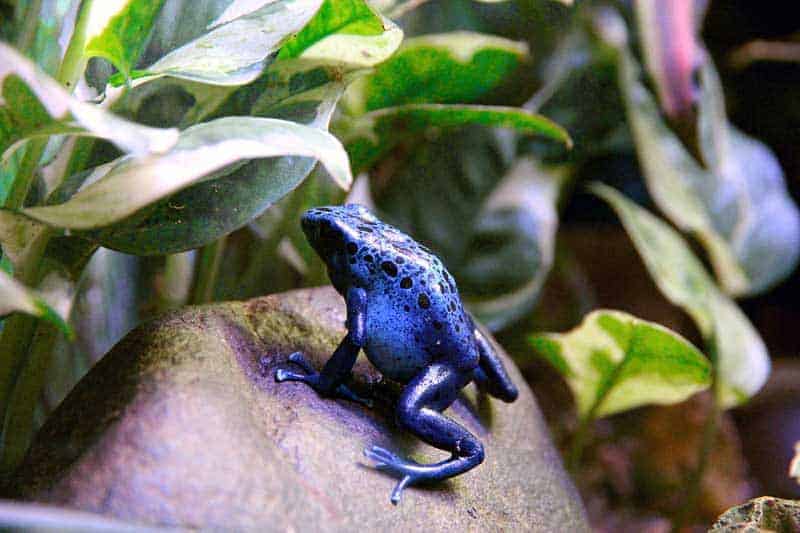
Scientific Name: Dendrobates tinctorius azureus
Found only in southern Suriname and far north Brazil, this small, brightly colored frogs are one of the most recognizable poison frogs. This is because they’re popular both as exotic pets and in zoo exhibits, Their vivid blue colors are a major reason for this popularity.
While these frogs does secrete poison from their skin, their name is a bit of a misnomer. They have actually never been used to create poison darts, only species in the genus Phyllobates have been used for that purpose.
4. Phantasmal Poison Frog
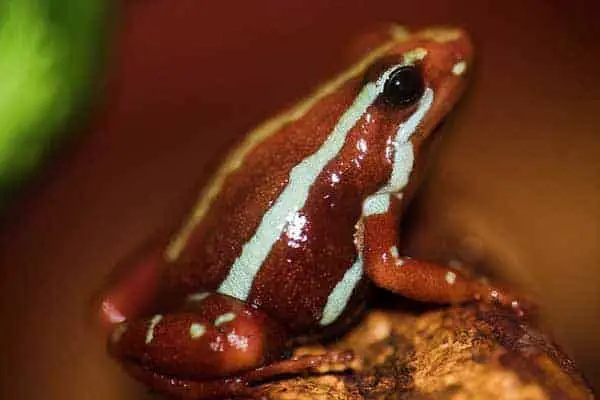
Scientific Name: Epipedobates tricolor
This highly endangered species lives only in central Ecuador, along the eastern slopes of the Andes mountains. It’s one of the smallest of the poison frogs, with most adults averaging about half an inch long. They’re named for their radiant gold and red stripes.
The poison secreted by this frog was once the subject of intense research, as scientists believed they could use it to create a non-addictive painkiller that would be even more effective than morphine. Unfortunately, it quickly became clear that the substance was too toxic for use in medicine.
5. Dyeing Dart Frog
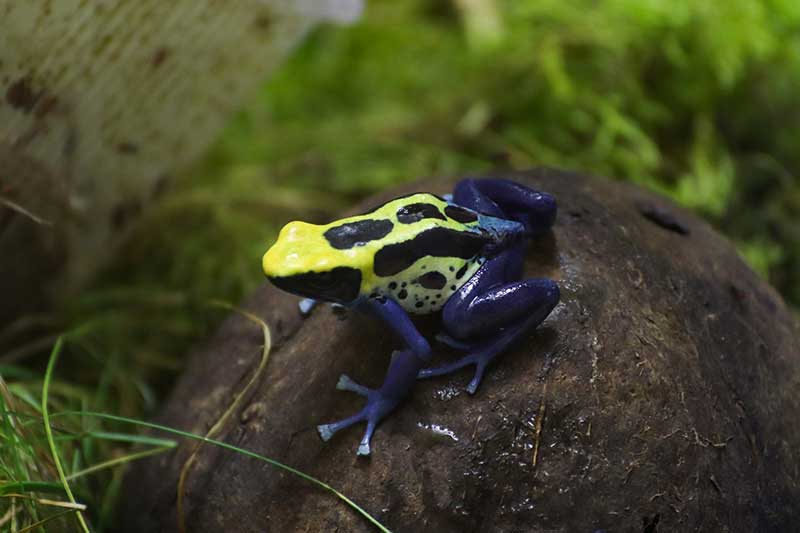
Scientific Name: Dendrobates tinctorius
Reaching up to 2 inches long, this species is unusually large for a poison frog. Living mainly in the northeastern regions of South America, they have deep black skin with bright yellow markings. The name “dyeing” comes from a legend that native tribes used the poison of these frogs to cause the feathers of parrots to change color.
Like the blue poison dart frog, the dyeing dart frog is highly toxic, but less so than members of the Phyllobates genus.
6. Strawberry Poison Dart Frog
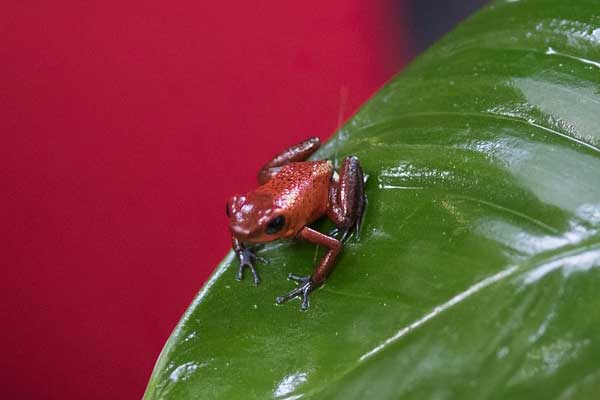
Scientific name: Oophaga pumilio
Inhabiting the tropical forests of Central America, the strawberry poison dart frog is widespread enough that it’s not currently threatened by habitat loss. It is the most toxic member of its genus, although it’s far from the most toxic of the poison dart frogs.
Strawberry poison dart frogs are very popular in captivity because of their bright, striking colors. The “blue jean” morph is especially popular- it’s body is red, but the blue coloring on its legs really dogs give the appearance of wearing blue jeans.
7. Kokoe Poison Dart Frog
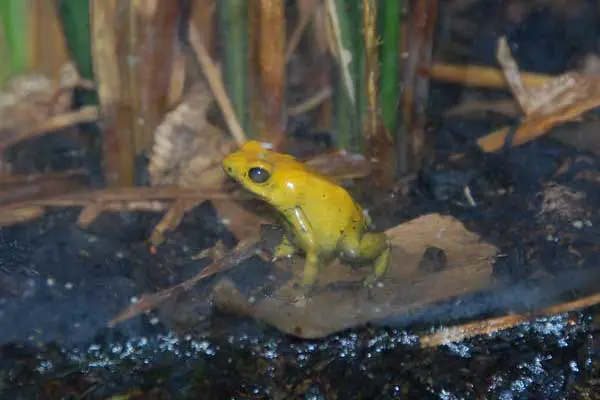
Scientific name: Phyllobates aurotaenia
The smallest of the poison frog, it’s also the third-most poisonous. Found on Colombia’s Pacific coast, these frogs have black backs with green or yellow stripes and blue or green spots on their legs. Like other members of the Phyllobates genus they have been used extensively by native tribes to poison the tips of hunting darts.
Unfortunately for the frogs, extracting the poison for use on darts was an unpleasant process for them. Since they release the poison only under stress, they were usually hung over a fire to cause them to excrete the poison.
8. Lovely Poison Frog
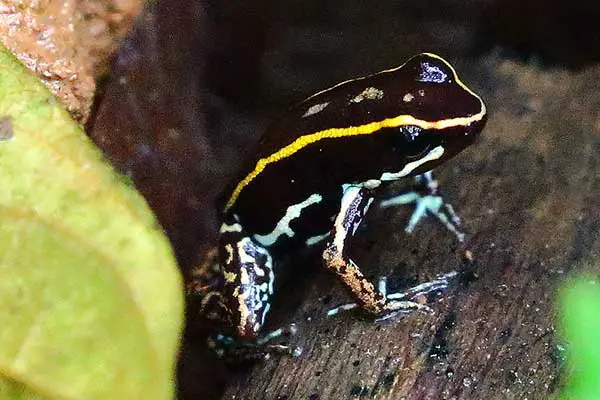
Scientific name: Phyllobates lugubris
These frogs are found on Central America’s Caribbean coast. They’re black with stripes that can range from yellow to orange. Although they are capable of generating poison, there are some wild populations of the lovely poison frog that are not toxic.
While they are threatened by habitat loss and pollution, the species is listed as Least Concern at the moment.
9. Golfodulcean Poison Frog
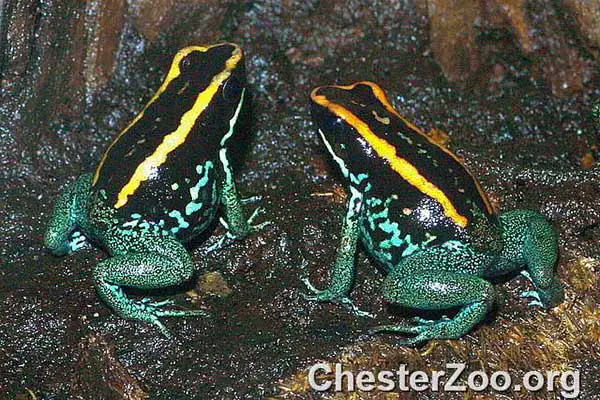
Scientific Name: Phyllobates vittatus
One of the most toxic of the poison frogs, the Golfodulcean frog lives only in Costa Rica. They have multicolored bodies, with black skin, a bright orange stripe down the center of the black, and blue and black speckled legs.
While it’s known that they obtain their poison from insects they eat, it’s not yet known which specific insects they get their poison from.
10. Red-backed Poison Frog
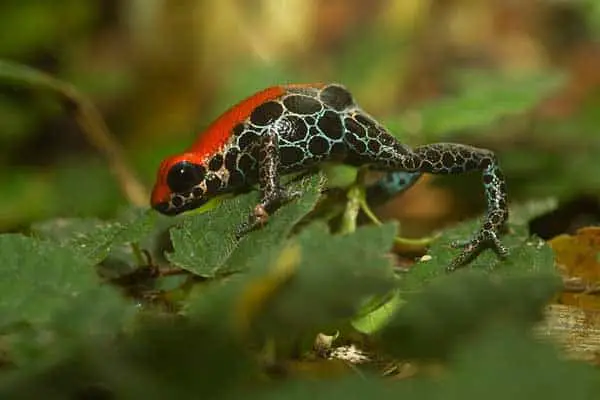
Scientific name: Ranitomeya reticulata
Living in the trees of Peru and Ecuador, the red-backed poison frog is grouped with the poison dart frogs although it’s never been used by humans to create poison darts. It’s not poisonous enough to kill an adult human, although it can still cause serious injury and has been known to kill smaller animals like chickens.
It’s one of the smallest species of poison frogs, and it’s characterized by a solid, bright red back and a unique pattern of black splotches on blue skin on the legs and lower back.
11. Variable Poison Frog
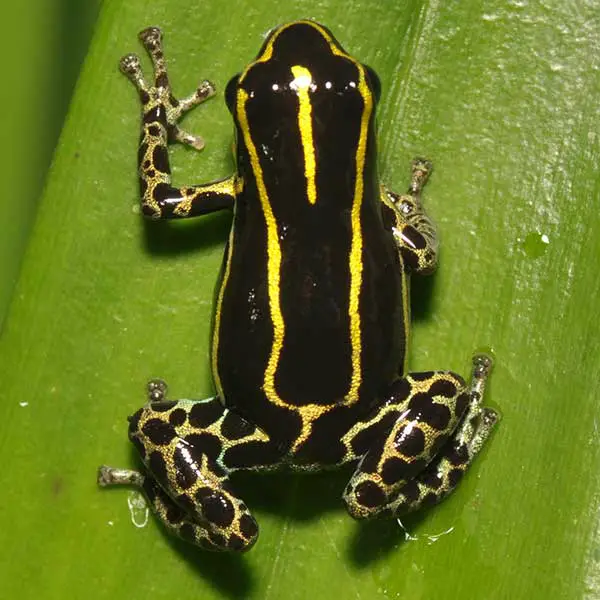
Scientific name: Ranitomeya variabilis
Also called Zimmerman’s poison frog, this is a small, little-understood species that lives deep in the rain forest high among the tree tops. They’re named for the surprising range of colors and patterns that they can exhibit, with some individuals displaying blue-green colors, others yellow and black, and still others bright red.
They live almost exclusively among the bromeliad plants that grow in the forest canopy, which makes them difficult to observe and study.
12. Green and Black Poison Dart Frog
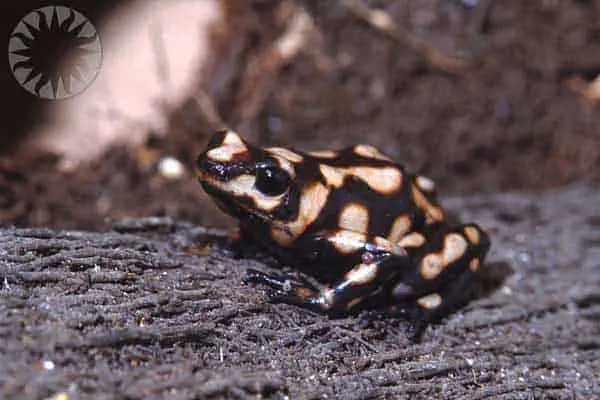
Scientific name: Dendrobates auratus
Native to Central America, this species has been introduced to Hawaii, which makes it one of the only poison frogs that’s been introduced beyond its natural habitat. The most common colors are mint green and black, presenting as mint-green skin and black splotches over the whole body. The shade of green can vary quite a bit, but the pattern typically remains the same.
They were introduced to Hawaii for mosquito control, although it’s not clear if they actually eat mosquitoes in significant numbers. Because of their small size and bright colors, they are very popular as exotic pets.
13. Granular Poison Frog
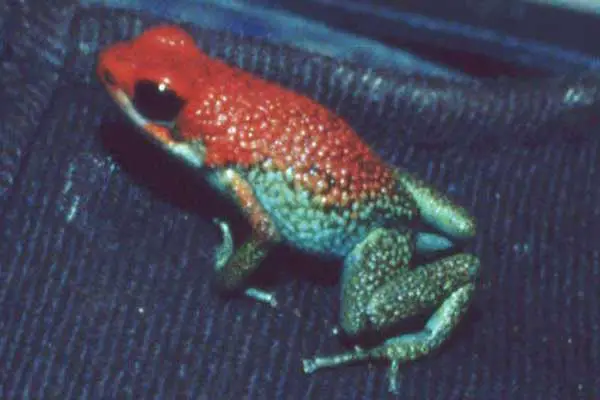
Scientific name: Oophaga granulifera
Native to Costa Rica and Panama, the granular poison frog is named for the pebbly texture of its skin, which is quite different from the smooth skin of most poison frogs. It has a bright orange-red head and back with bluish-green legs, arms, and underparts.
They’re terrestrial, rather than arboreal, and spend their whole lives on the ground. They lay their eggs in low-lying plants rather than high up in the trees.
14. Yellow-banded Poison Frog

Scientific name: Dendrobates leucomelas
Living in a small region of northern South America, largely within Venezuela, this frog is black with bright yellow bands across it’s body. You’ve probably seen quite a few of them in zoos and aquariums, or in pet stores.
Because they wild population is large and stable, and the frogs breed well in captivity (and seem to handle life in captivity quite well), they extremely common in captivity and also relatively cheap compared with other poison frogs.
15. Harlequin Poison Frog
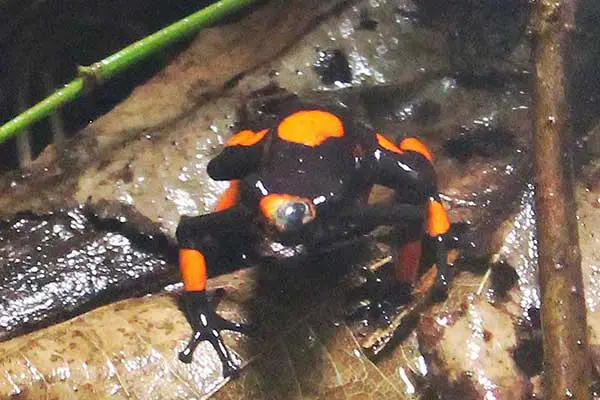
Scientific name: Oophaga histrionica
A terrestrial species native to Colombia, the Harlequin Poison Frog likes to hide among the leaf litter on the forest floor. For that reason, it’s colors are relatively subdued compared with other species of poison frog. The base color is usually orange with black webbing all over the body.
This species is very rare in captivity, because they don’t typically handle captivity well and are difficult to breed. As such, the few individuals available in the pet trade are highly sought-after and expensive. Still, it’s best not to try and keep these frogs as pets.
16. Corroboree Frog
Scientific Name: Pseudophryne corroboree
Undoubtedly the most unique frog on this list, the Corroboree frog can be found living wild in very small regions of Australia’s southern tablelands in New South Wales. They have black skin with yellow spots or stripes.
In addition to being the only poison frogs not native to Central or South America, they’re also the only poison frogs that produce their own poison rather than obtaining their poison from their diet. They are highly endangered as a result of extensive habitat loss.
